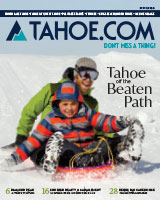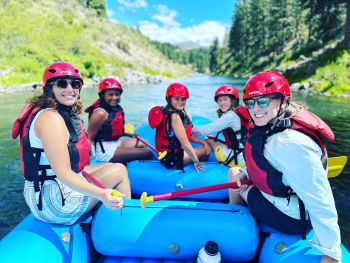Lake Tahoe is a stunning scenery rich in colors, textures and appearances. One day the lake may be glistening in all of her glory with a landscape coated in sparkling diamonds of freshly fallen snow. The next moment (in sometimes as little as 10 to 15 minutes) her mood may change and dark, foreboding storm clouds descend quickly bringing raging winds and torrents of snowfall or rain. If it is summer the opposite is known to occur — extreme heat providing a tinderbox affect to the Tahoe Basin making fire danger extreme...tens of thousands of acres burnt in a single evening from high winds and a careless mistake by a human.
Mother Nature is the all mighty in Lake Tahoe. That's part of the reason the area is so beautiful. It is during these moments of torrential downpours, strong winds and incredible storms that we humans begin to realize we are a tiny fleck in this grand expanse of earth. Lake Tahoe is a special place, and she deserves respect and care. Learning how to care for Lake Tahoe brings an aliveness, realness and sparkle to this mountainous region when playing in her big playground. And knowing how to respect her brings a level of safety to everyone who ventures out into this wondrous place.
Lake Tahoe
Lake Tahoe is a true jewel. As the third-deepest lake in North America and the 11th in the world (with an average depth of 1,000 vertical feet, 1,645 at its deepest), the intensity of water in combination with being surrounded by stunning mountains makes her brilliance more amplified than in other places. The depth and variations in the water create lovely, varying hues of blue that are reminiscent of the tropics, yet her water is frigidly cold. Keeping in mind the depth of the lake, the intensity of the storms that can present themselves in both summer and winter and the intense cold of the water, it is important to know when playing on Lake Tahoe to be safety aware. If on a paddleboard, stay close to land and have a life preserver. If in a power boat, have all of the necessary emergency equipment and an escape plan devised if things go wrong on the water. If swimming, keep in mind that the farther out you go the colder it gets. Do what is in your comfort zone with a friend's eyes on you if possible. If you're interested in participating in keeping Lake Tahoe beautiful and learning more about how to stay safe when playing on the lake, please visit KeepTahoeBlue.com.
The Mountains
Lake Tahoe is absolutely gorgeous in her own right, but what really highlights her beauty are the mountains that surround her. Incredibly friendly for mountains, Tahoe's Sierra Mountains are nicely forested, offering lovely single-track ski trails that let you get deep into the wilderness quickly and with ease (i.e. there is very little bushwhacking or struggle if you stay to marked trails). But that isn't to say that precaution should be thrown to the wind when venturing into the Sierras. The trail system is extensive and for the most part taken care of, but be aware that it is each person's responsibility to have proper outdoor clothing, the appropriate workable equipment and the knowledge of how to take care of oneself if something goes wrong. In the summer it is mandatory to get hiking permits for backpacking trips into wilderness areas. These can be obtained at ranger stations. Desolation Wilderness requires permits for day hikes as well as overnight trips. The day use permits are available at trailheads and are in a self-serve kiosk. Permits are free except for Desolation, which is $5 a day.
In winter the snowshoeing, cross-country, snowmobiling and backcountry skiing can be fantastic, but there is incredible danger out there at the same time. Avalanches are frequent in the Tahoe mountains. Varying temperatures, high winds and intense storms create the ideal climate for slides to occur. It is imperative to have an avalanche beacon, probe and shovel (and know how to use them) if traveling into the wilderness when there is snow on the ground...even if it is springtime. In the summer temperatures can be extremely warm during the day (sometimes hitting 100 degrees fahrenheit) and then extremely cold at night (that same day may plummet to 30 degree fahrenheit). Not having the proper clothing and protection equipment can lead to hyperthermia and other potentially disastrous scenarios. It's also vital to be aware of dehydration. The higher elevations and strong sun play a huge role in the body having to use much more water than usual. Drinking more water than one is accustomed to is highly suggested. In respect to the higher elevations, it is also important to take things slow if coming from sea level. Lake Tahoe is at 6,224 feet, thus making the mountains substantial. Elevation sickness is a real occurrence in Lake Tahoe and can be deadly if not taken seriously. And, at the very least, the difference in altitude will make most flatlanders very breathless, so take it easy.
The Wildlife
As Lake Tahoe has become more popular, the building and influence of human beings has brought the sightings and interactions with wildlife more frequent. In some cases this is cute and fun. For example, bunnies have become an animal that are showing more presence in north Lake Tahoe. But on the other side of the coin, the garbage that comes with the increase of humans has created a larger presence of predator-type animals such as bears and coyotes. Unlike 20 years ago, bear sightings in Lake Tahoe are frequent and often quite destructive. It is vital for the health of your car not to leave any food or drink remnants in the car overnight (wrappers included). Bears have been known to peel a car door off its hinges like it's a sardine can. Bears are also crafty with breaking into houses. Don't leave garbage out. Always store garbage in a bear-approved container, i.e. a bear box. If a bear does come within your vicinity, become large, make lots of noise and make a presence. When it comes to coyotes, it's important to note that they are incredibly crafty animals that tend to work together to take down large prey (dogs and humans included). Because of the ever-increasing presence of garbage and humans in Lake Tahoe, the coyotes have found a new food source that they are becoming quite aggressive about. It is incredibly important to be vigilant on garbage control and not leave any food out (including food residue from barbecuing). The same precautions that apply to bears apply to coyotes. If you do find yourself being circled by coyotes, make a ton of noise. Jump up and down. Shoo the coyotes away. Make your presence known and slowly vacate the area. If you would like to learn more about how to stay bear safe in Lake Tahoe, please visit the BEAR League based out of Homewood at SaveBears.org.
The Weather
As mentioned above the storms that can frequent Lake Tahoe are incredible in their strength. The winds can reach more than 100 miles an hour on the ridges. It can snow more than 5 feet in a night (sometimes 10). The storms come in quick and they arrive with vengeance. This can be scary if you aren't prepared. But all is good with knowledge. If you find yourself in the midst of a Lake Tahoe snowstorm, be sure to have the proper car to travel in snow. Driving in chains doesn't always cut it in when the storms are raging. If possible it is highly recommended to have a 4WD or all-wheel drive if coming to Tahoe during a storm cycle. Due to the intensity of the snow storms, this can create high avalanche danger in the mountains. Be wary of traveling into mountainous areas during storms or traveling on roads that are in avalanche zones. Be sure to always carry a shovel, flashlight, extra blanket and potable water with you. During large storms the snow that is removed from the roadway creates snow berms (walls). These snow berms are outlined with large snow sticks that look like poles. These poles are to help guide you and the snow plows when the visibility becomes diminished. Be careful of not getting too close to the snow berms, though. They are easy to get stuck in. In relation to getting stuck, it is normal for there to be chain control stops on major roadways during heavy snowfall. During these times it is mandatory for all cars to have chains, and it's sometimes even required of 4WDs (but not always). It is illegal to pass through these stop points without stopping. It is also important to note that although Lake Tahoe is in California and the weather can be amazingly beautiful, even on hot days the temperatures can plummet at night. Be sure to bring a coat and proper clothing to stay warm, even in the summer. For information about road conditions visit CalTrans to learn up-to-the-minute details.







